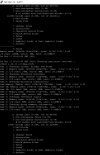My Humax tody had lost many of its recording (in the display) and no thumbnails.
I rebooted and it has recovered.
I thought I had better take a look but could not access WEB i/f for a few Hrs ... kept getting ERROR 500 though I could ping the Humax OK
(I guess this could be unrelated to my box)
This afternoon web i/f now working again ... so thought I ought to look at its health ...
Rebooted Box into Maintenance mode
Under diagnostics where can I find a list of diagnostic options? ....... on screen it only has 'Diag'
I went to the Wiki page

 wiki.hummy.tv
It lists Fdisk options but nothing for Diag options ?
wiki.hummy.tv
It lists Fdisk options but nothing for Diag options ?
Welcome some advice on what I should be doing for a health check.
I rebooted and it has recovered.
I thought I had better take a look but could not access WEB i/f for a few Hrs ... kept getting ERROR 500 though I could ping the Humax OK
(I guess this could be unrelated to my box)
This afternoon web i/f now working again ... so thought I ought to look at its health ...
Rebooted Box into Maintenance mode
Under diagnostics where can I find a list of diagnostic options? ....... on screen it only has 'Diag'
I went to the Wiki page

Maintenance Mode Disk Check
Welcome some advice on what I should be doing for a health check.
Last edited:



